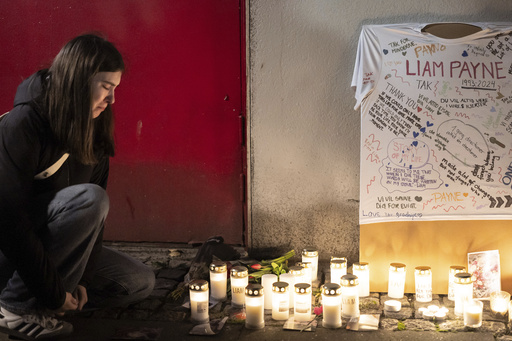
Liam Payne’s voice opens the iconic debut single “What Makes You Beautiful” from the groundbreaking boy band One Direction, which bursts forth with an infectious guitar riff and a lively touch of cowbell. As he sings, “You’re insecure, don’t know what for / You’re turning heads when you walk through the door,” he offers reassurance to fans of all ages, encouraging them to embrace themselves more fully.
Tragically, Payne passed away on Wednesday after a fatal fall from a hotel balcony in Buenos Aires, Argentina, at the young age of 31. He also had the honor of being the last solo voice heard in One Direction’s concluding single “History,” meaning he initiated and concluded the remarkable journey of one of music’s most successful boy bands.
The details surrounding his untimely death are still being investigated; Buenos Aires police reported that Payne “had jumped from the balcony of his room,” but did not elaborate on how they concluded this or whether it was intentional. Nevertheless, Payne played an instrumental role in shaping One Direction’s legacy as the first widely recognized boy band of the internet age, earning a special place in the hearts of millennial and Gen Z fans.
Before they became the sensation known as One Direction, the group’s members—Harry Styles, Niall Horan, Louis Tomlinson, Zayn Malik, and Payne—auditioned separately for the U.K.’s “The X Factor.” After their individual auditions, the judges assembled these five promising young men into a cohesive group. Collectively, they placed third in the 2010 competition.
As noted by Rob Sheffield, a contributing editor at Rolling Stone, this unconventional method of forming a boy band was unprecedented. He remarked, “They were sort of assigned to be together. And you don’t expect longevity out of that situation,” stating that typically, such formations do not yield even one successful pop hit. However, One Direction not only succeeded in their debut but also originated a new model for pop stardom.
Thanks to this television platform, initial fans could start following the band’s journey leading up to their official launch in 2011. Fans utilized emerging social media sites like Twitter and Tumblr to connect, mobilize and directly interact with the members. “I honestly made a Twitter so that I could keep up with One Direction, and that’s how I made so many different friends,” recalled Gabrielle Kopera, a 28-year-old California fan who cherished the band’s early livestream chats. “Sometimes they would say something back and it was so much fun. I feel like that fan interaction doesn’t even happen anymore.”
This approach fostered a sense of accessibility between the band and its fans. Maura Johnston, a freelance music writer, noted that the group’s rise to fame on a British TV show catalyzed their rapid ascent into a global phenomenon, largely fueled by the tools of social media.
One Direction graced the lives of both millennial and Gen Z audiences with their catchy tunes and compelling personas, a cultural milestone in an era markedly different from today’s fragmented media landscape. Johnston pointed out that in the early 2010s, media exposure was more unified and not yet influenced heavily by algorithmic sorting.
While their omnipresence undoubtedly contributed to their success, the band’s appeal lies in more than just being everywhere. They were distinct individuals with unique musical styles, as Sheffield observed. They also defied the traditional norms of boy bands by co-writing many of their songs and avoiding the clichéd choreography common among their peers.
In the wake of the news regarding Payne’s death, Kopera reported receiving numerous messages from friends she hadn’t spoken to in years, reflecting a collective sense of loss. Fans gathered outside the Casa Sur Hotel in Buenos Aires, creating an improvised memorial of flowers, candles, and heartfelt notes, guarded by police as evidence of their sorrow. “To see that he died and that there will never be another reunion of the boys is unbelievable; it kills me,” stated Juana Relh, an 18-year-old fan.
Within the group, Payne was often perceived as the “brooding” older brother type. He played a crucial role in songwriting, contributing to pieces like “What A Feeling” and “Fireproof.” In a heartfelt Instagram tribute, Tomlinson referred to Payne as “the most vital part of One Direction,” highlighting his talents and contributions.
In recent months, Payne had openly discussed his battle with alcoholism, indicating in a YouTube video from July that he had maintained sobriety for six months following treatment. Authorities found clonazepam and other medications in his hotel room, alongside a whiskey bottle. “It just feels like he needed help,” Kopera said of the circumstances surrounding his death, expressing concern about how the entertainment industry can consume artists.
After One Direction disbanded in 2016, Payne’s solo career struggled to gain traction compared to some of his former bandmates, with Sheffield noting he had become “the least successful.” “Transitioning from being a boy bander to being a pop star is hard,” Johnston added. During his solo performances, Payne would showcase montages of One Direction’s concerts, an unusual move for an emerging solo artist but reflective of his gratitude for their shared journey.
Despite the struggles he faced, Kopera believes, “his legacy is going to always point back to One Direction.” For fans, this holds true as well. “One Direction was the soundtrack to growing up, and I’m so thankful for it,” Kopera expressed, emphasizing that they were just a group of relatable boys who resonated with many across different backgrounds.
